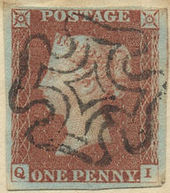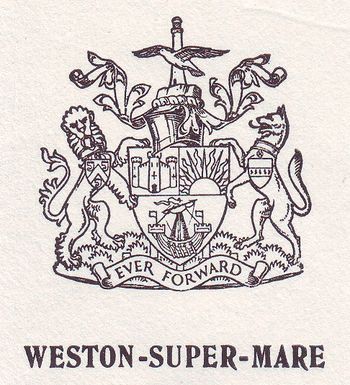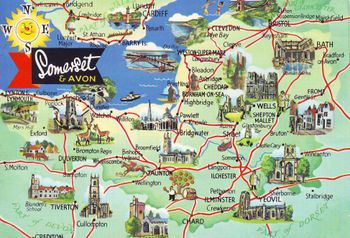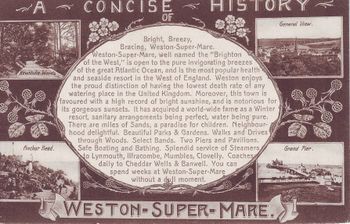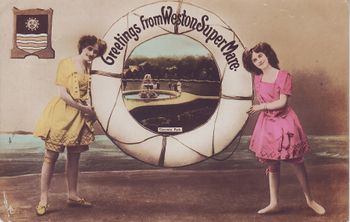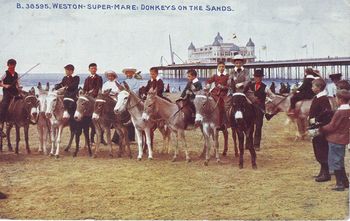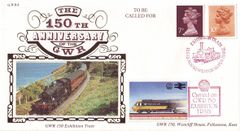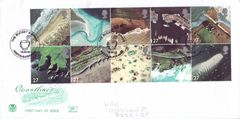Loading map...
{"minzoom":false,"maxzoom":false,"mappingservice":"leaflet","width":"auto","height":"200px","centre":false,"title":"","label":"","icon":"","lines":[],"polygons":[],"circles":[],"rectangles":[],"copycoords":false,"static":false,"zoom":12,"defzoom":14,"layers":["OpenStreetMap"],"image layers":[],"overlays":[],"resizable":false,"fullscreen":false,"scrollwheelzoom":true,"cluster":false,"clustermaxzoom":20,"clusterzoomonclick":true,"clustermaxradius":80,"clusterspiderfy":true,"geojson":"","clicktarget":"","imageLayers":[],"locations":[{"text":"","title":"","link":"","lat":51.352273,"lon":-2.976265,"icon":""}],"imageoverlays":null}
Weston-super-Mare postmarks and postal history

Map showing the position of the new
Cross Penny Post on the
Bristol-
Bridgwater and Weston-Wells roads
Before 1805 the tiny fishing village of Weston-super-Mare had no official post. A branch post was then established on the Bristol – Axbridge ride for a foot messenger from Wrington to Worle (see Cross PP map Right) on 3 days a week. Receiving houses were set up at Banwell and Worle by 1816 and at Weston itself by 1817, when it became a 5th Clause Post under Bristol. It is not known whether any marks were used during the period before 1826 when Weston became part of the Bristol Penny Post and used the No. 28 Receiving House handstamp for use from 26th April. At the end of September 1827 Weston was transferred to the new Cross Penny Post system. Cross was situated conveniently on the crossroads of the then new Bristol – Bridgwater coach route and the Weston – Wells road. A new handstamp No. 2 was issued in 1829 which was used until 1840 although the old one can still be found.
In 1840 Weston was issued with a standard Maltese Cross and a 30mm dated double arc handstamp with serif letters which was superseded in 1850 by a smaller one with sans-serif letters. This is known in black, yellow, blue and a greenish grey.
The number 871 was allocated in the first list of 1844 and was first used as a horizontal oval with 4HOS in black or blue. In 1849 a 3HOS version was released. Vertical ovals were issued with 3VOS in 1872, 1877 and 1879 but these are extremely rare. Locally made wooden versions with 3VOS, 2VOS and even 1VOS are known but dated examples are not recorded according to Parmenter (but see my 1900 parcel post label). Duplexes were issued in various formats, first sideways, upright with circular and oval numerals, these 4VOD and later 3VOD. Collection time was originally shown by time codes with letters from B through L and Z. Whether all letters were used on all duplexes I do not know! On changing to times in clear there were apparently 2 morning times (630AM and 1030AM) and several afternoon collections (from 1215PM until 1015PM).

Old Weston-super-Mare General View (about 1835) The Post Office and Old Stables for coaches can be seen to the right of the church, With a mail coach about to turn in.
Squared circles were also used for a short time (1881-1885). There is just the one type but again with time-codes.
Various circular datestamps were in use from 1861, often for forwarding or other non-standard use. There are single and double circles in different formats, the double circles having arcs and cross pattees at base. A version with thinner arcs has been reported but I have not seen it. The correct way of writing the town name is with hyphens but some stamps were also without. Large skeleton postmarks were in use in 1906, again with time-codes. Registered oval postmarks were used as were undated circular parcel post stamps. There was also a dated PP circular stamp which can be found. Triangular dies are known with 871, A871, B871 and WM for printed papers etc.
As Weston was still a fairly small town none of the various machine trials were carried out here. Continuous Krags with straight and wavy lines were used as were various single impression Internationals.
In the early days of slogan postmarks Weston took part but I do not have an overview of which ones are available. I just show the ones I have. There were quite a number of local postmarks used at individual offices when accepting post there and also for parts of the town or its suburbs. In modern times the 1970’s show the attempt to bring Weston into the new county of Avon which was strongly opposed locally. Somerset, Somerset A, Somerset B. North Somerset, Avon, Avon A and Avon B are all to be found within the postmarks used during that time. In the meantime, Weston seems to have disappeared completely from the postmarks, replaced by Bristol…Taunton.
Area History
Early in the 19th century, Weston was a small village of about 30 houses, located behind a line of sand dunes fronting the sea, which had been created as an early sea wall after the Bristol Channel floods of 1607. The Pigott family of Brockley, who were the local Lords of the Manor, had a summer residence at Grove House. Weston owes its growth and prosperity to the Victorian era boom in seaside holidays. Construction of the first hotel in the village started in 1808; it was called "Reeves" (now the Royal Hotel). Along with nearby Burnham-on-Sea, Weston benefited from proximity to Bristol, Bath and South Wales. The first attempt at an artificial harbour was made in the late 1820s at the islet of Knightstone and a slipway built from Anchor Head towards Birnbeck Island.
Large areas of land were released for development from the 1850s onwards. Large detached villas, for the middle classes, were built on the southern slopes of Worlebury Hill. Semi-detached and terraced housing was built on the low "moorland" behind the sea front in an area known as South Ward. Many of these houses have now been converted into bedsits. Most of the houses built in the Victorian era are built from stone and feature details made from Bath Stone, influenced by local architect Hans Price.
In 1885, the first transatlantic telegraph cable of the Commercial Cable Company was brought ashore and the company started a long association with the town, ending in 1962.
Guglielmo Marconi, the inventor of wireless telegraphy, successfully transmitted radio signals across the Bristol Channel in the spring of 1897, from Penarth (near Cardiff) to Brean Down (just south west of Weston, on the other side of the River Axe).
A second railway, the Weston, Clevedon and Portishead Light Railway, opened on 1 December 1897, connecting Weston to Clevedon. The terminus station was at Ashcombe Road. The railway was extended to Portishead on 7 August 1907 but was closed in 1940.
Postmark Examples
Weston-super-Mare was allocated the 871 Post office numeral.
Provincial Mail coaches serving Weston-super-Mare.
The Provincial Stage Coach services ran from Bristol to Weston with coaches serving the town.
Coach 217 The Sovereign ran from The Bush Coach House on Corn Street Bristol to Bourton - Backwell and Cleave daily leaving at 9am.*
Coach 218 The Hope ran the same route on Monday, Wednesday, Thursday and Saturday leaving at 4pm for Weston.*
Coach 223 ran from The Three Queens on Thomas Street, Bristol to Banwell daily, it continued to Axminster, Cross, and Sidcot on a Tuesday Thursday and Saturday.*
Coach 226 ran from The Swan Coach House, Bristol to Weston 4 times a week.*
* Cary's New Itinerary or an accurate delineation of the Great Roads both Direct and Cross throughout England & Wales. 1815 (14th Ed. c.1836)
Prephilately - 1849
Early days of Maltese Crosses, double arcs and horizontal ovals
 Weston became part of the Bristol Penny Post in 1826 and was allocated No.28 Receiving House handstamp which was in use for 18 months. |
 1827 transferred to the new Cross Penny Post system. In 1829 No.2 was issued and used until 1840. No.6 as here does not seem to be recorded for Weston. |
 1827 transferred to the new Cross Penny Post system. In 1829 No.2 was issued and used until 1840. |
 1831 example of Cross No.2 Receiving House. |
 Maltese Cross used in Weston 1842 with typical double arc - first type - on reverse |
|
 Maltese Cross on plate 34 1843 |
 Maltese Cross 1843 reverse |
 The first horizontal oval from 1844 had 4 HOS |
 Reverse with double arc August 1844 transit double arcs of Bath and Bristol |
 1846 double arc used on front rather than reverse, Bristol receiver on reverse and offset on front |
 1849 double arc used on front plus circular paid |
1850 - 1859
Early developments with new horizontal oval 3HOS, introduction of sideways duplexes and then upright duplexes
 second horizontal oval 3 HOS on 1850 cover with Archer plate 99 experimental perforation |
 1852 Penny Pink with 3 HOS horizontal oval |
 1852 reverse showing the new double arc type in yellow and Taunton double arc in yellow |
 1852 cover with 3 HOS oval in blue also reverse with double arc in blue - plate 136 |
 1858 sideways duplex without time code on plate 60 |
 1858 sideways duplex with time code here on Penny Pink |
 1858 cover sent from Uphill via Weston to London with 2d rate and sideways duplex on plate 46 |
 1858 reverse showing Uphill undated double arc and London morning (red) receiver small circle |
 August 1859 very early usage of the upright duplex (plate 60), first sent only 10 days earlier. Parmenter records 1861 as first usage! |
1860-1869
Weston was growing into a seaside resort for the wealthy. More post going abroad
 July 29th 1867 Very late usage sideways duplex, 3 months later than recorded by Parmenter. Timecode B. Redirected to new delivery area so 1d. postage due |
 1865 sideways duplex - timecode C Applied upside down |
 1860 sideways duplex - timecode D |
 1867 sideways duplex - timecode F 4d rate to France via London with Calais transfer mark and red PD - paid to destination |
 1866 sideways duplex - timecode F - 1/- rate to USA - SG 101 (wmk enblems) plate 4 red paid and red 21 cents cancel |
 1865 upright duplex with circular town stamp - timecode E 6d rate to Switzerland and red PD cancel. Stamp with top marginal inscription |
 1867 upright duplex with circular town stamp and local usage - timecode F |
 ditto reverse showing local backstamps. Letter presumably sent from Wedmore with code C to Weston and stamp cancelled there and arrival in Axbridge next day |
 1867 letter to Weston, forwarded to new address using a single circle, early usage with hyphens in the town name. CH charge mark as new delivery area |
1870-1879
The first vertical duplexes appeared
 1871 upright circular duplex with timecode D |
 1870 upright circular duplex timecode F, new 3d rate to Switzerland and red PD |
 1870 upright circular duplex but year date transposed with 7 upside down! |
 1873 first vertical duplex 4VOD, timecode D, 11 days earlier than recorded by Parmenter. Looks smaller than the next ones but is not! |
 1874 vertical duplex timecode B |
 1875 vertical duplex timecode C |
 1875 vertical duplex timecode F |
 1876 vertical duplex timecode G |
 1877 vertical duplex timecode J |
 1878 new vertical duplex, oval higher at 35mm and town circle smaller than before, timecode K |
 1878 ditto timecode L, used on stamped-to-order wrapper embossed and dated 27.06.1878 |
 1878 reverse of this wrapper showing local Birnbeck Road Weston-super-Mare original postmark with code C |
1880-1889
The decade of squared circles and switch to 3VOD vertical duplexes
 1880 vertical duplex 4 VOD large, timecode D |
|
|
|
 1888 code L, second 8 in date broken |
 1882 squared circle, 14 dots code C |
 1882 code D, rare bluish lilac shade and 14 dots, bought from Cohen |
|
|
|
|
|
 1885 vertical duplex new form 3VOD, 6d rate to Burma, code F |
|
|
|
 1889, registered cancels on penny pink cover to France with extra threepence halfpenny |
1890-1899
Double circles launched; first parcel post and locally made wooden handstamps
 1892 vertical duplex oval 4VOD, code I to Italy |
|
|
|
 1896 ditto time 730PM to Austria |
|
|
|
|
|
|
|
 1898 double ring with single arc 1245PM and oval registered code B |
|
|
 1899 ditto 1030PM and smal Cheddar single circle earlier that day |
 date unknown parcel post double circle |
 date unknown 3VOD handcut vertical ovals, 7 very different |
 1895 4VOD but clear Regent Street local office stamp code A |
1900 -1909
Weston was thriving and many workers from the Midlands took their holiday here. Single circles and in 1906 the large skeletons used
 Important event 1904 Grand Opening of The Grand Pier |
 1902 double circles without time codes, local postmark Claremont, combination cover QV and EVII |
 1900 double circles 1245 and 415PM on control singles |
|
|
|
 1901 double circle 1030PM on IR official |
 1906 small double circle 115PM used for forwarding. Note Bristol receiving mark 134 as horizontal oval late use |
|
 1903 single circle 1030PM |
 1903 local cover Wells to Winscombe on IR official |
 reverse of same showing very early 2AM transfer in Weston with single circle |
 1904 registered oval to India. Note purple Bombay - Aden Seapost registered mark |
 1906 large skeleton 530PM |
 1906 ditto 730PM - there are others but place is limited! |
 1907 purple local postmark single circle from Milton to Milton |
 1905 PP label with Money Office single circle postmark, code A |
 undated early 1900s PP label with purple parcel post double circle and single circle PP |
 wow! 1900 PP label abroad combining half crown stamp and 1/- Jubilee red and green stamp, handcut 871 vertical ovals and single circle PP with date! |
1910-1919
Postal mechanisation reached Weston, slogan postmarks and the Great War
 1910 single circle, no time code |
 1911 with time code 715PM |
 1912 with time code 1030PM, underpaid - Liable to Letter Rate 871, 1d black by hand |
 1911 small double circle time 2PM |
 1914 unrecorded for Weston Columbia single impression |
 1919 for comparison continuous Krag impression |
 1918 continuous "Buy National War Bonds" |
 1917 single circle Uphill 6PM |
 1914 purple handstamp single circle Milton |
 1910 small 20mm single circle Worle code C |
 1910 ditto 22mm Bleadon no time code |
 1913 PP label Church Road with local office cancel code A |
 1912 PP label Whitecross Street (sic) corrected by hand and Whitecross Rd local office cancel code asterisk, also black double circle parcel post cancel |
 1912 International Reply Coupon 3d with PP single circle |
1920-1929
The aftermath of the War in postal slogans leading to the depression
 1920 Krag continuous impression without time |
 1923 Krag continuous impression wavy lines |
 1929 International single impression double circle 5 wavy bars |
 1923 unclear large circles, single circle no time |
 1921 double circle with arcs and cross pattee 845PM, 2d to pay 871 |
 1927 double circle short arcs SOM. below |
 1926 slogan postmark British Goods are best |
 1926 slogan postmark Join the King's Roll |
 1920 local single circle Baker Streetand hooded circle registered cancel without town. Not known with Weston imprint |
 1923 local single circle The Boulevard and typical red London hooded circle registered |
 1925 local single circle Locking Road with asterisk time code on POSB 1/- stamp |
 typical parcel post rubber stamp |
1930-1939
The thirties were quite successful until the Second World War started
 Important event 1935 the Floral Clock to celebrate the Silver Jubilee - the clock changed every year and postcards are available until the 70s |
 1932 International 5 wavy lines and double circle here applied twice! |
 1932 ditto with an extra large double circle for some reason. Somerset at base |
 1935 Unified 7 wavy lines and single circle - Som. at base |
 1937 single circle Somt included in the round text. Asterisk for time code. Underpaid Express letter, slightly philatelic! |
 1937 double circles with small arcs and Somerset at base. Overfranked philatelic |
 1937 oval registered cancels on underpaid Express letter, philatelic |
 1939 slogan postmark Road Users take Care and avoid Risk |
 late 1930s undated unified 7 wavy lines with telegraphic code 871 for printed paper |
 there were also triangular postmarks with A871, B871 or as here W.M |
 1937 local Claremont single circles with Asterisk time code on local registered letter, again philatelic |
 1937 local Uphill single circle on local airmail letter at standard rate as normal |
 1938 Neopost meter GV still with double base frame on fantastic advertising envelope |
 1937 Post Early in the Day |
1940-1949
War and post-war period. Lots of slogans
 1942 double circles on 1/3d airmail letter to USA |
 1948 double circle with text unusually at base and county following town name |
 1949 unified 7 wavy lines in 3 parts |
 1947 with 2d to pay 871 handstamp applied |
 1940 Post early for Christmas |
 1948 Post early for Christmas incorporating holly |
 1945 Victory Bells Europe |
 1946 Take no chances, keep death off the road |
 1947 Blood donors are still urgently needed |
 1947 Volunteer for a forces career |
 1948 Post early in the day |
 1948 A distinguished career - nursing - also 2 hand-stamped double circles. Liberation stamps were available at Bristol Main PO but not Weston |
 1948 Lend a hand on the land |
 1947 Staggered Holidays for Comfort |
 1941 meter style unified 1d paid in red |
 1942 Neopost meter stamp with continuous bottom frame line and advert for the Gas Board |
1950-1959
The Coronation started the new decade and tourism boomed
 1951 unified as before, here on rare advertising envelope for the town |
 1953 same postmark but waves upside down. Commercial usage of a beautiful stamp |
 1957 same postmark but now SOM.A. at base |
|
 1953 here with postage due handstamp 1d to pay, liable to postcard rate 871 |
 1953 single rubber circle on 3rd step letter to Austria |
 1955 double circle on FDC of the first Castle £1 stamp from Waterlow from set of 4 covers |
|
 1953 Postage on Letters for Europe 4d |
 1954 Save Time Buy 2 1/2D Stamps in Books 3/9D a Book |
 1956 Civil Defence Join now |
 1958 Express good wishes by Greetings Telegrams |
 1959 Cheap Rate Trunk Calls 6PM - 6AM & Sunday Afternoons |
1960-1969
The Weston Donkey was launched as an advertising figure. No examples of Rhodesian UDI post to Weston seen yet
 1965 double circle with thin arcs |
 1968 unified wavy lines, county as Somerset.B. |
 1968 black rubber single circle. 8D to pay posted unpaid 871 as green handstamp. Dues cancelled but illegible |
|
 1968 registered cancel on certificate of posting |
 1963? Simplex meter stamp from Halifax Building Society |
 1968 local Baker Street single circle on certificate of posting |
 1963 local Locking Camp single circle on FDC |
|
|
 1961 Post Office Savings Bank centenary |
 1962 Civil Defence is Common Sense |
 1963 the Weston donkey with sunglasses |
 1964 the new Weston donkey without sunglasses |
 1964 ditto but town circle upside down |
 1967 Wessex Philatelic Convention on cover with Weston-super-Mare coat of arms |
|
1970-1979
No postmark development apart from the local "war" whether Somerset or Avon
 1970 unified wavy lines Somerset.B |
 1974 single circle handstamp on Premium Bond |
 1976 Neopost meter with German postage due stamp |
|
|
|
 1970 The Dairy Festival Pintas fill the energy gap |
 1973 Bristol Light Opera Club presents Kismet at the Bristol Hippodrome October 9th - 20th 1973 |
 1973 Philatelic Exhibition |
 1974 Remember to use the Post Code Somerset |
|
 1976 ditto text transposed |
|
1980 and later
The postal war continued
 1988 unified wavy lines first class stamp so Avon.A. |
 1992 ditto second class stamp so Avon.B. |
 1990 ditto in red AvonB without full stops |
 2002 large handstamp single circle now North Somerset |
 1981 registered oval cancel |
 1990 local Baker Street cancels but Bristol registered label! |
 1982 local Steep Holm handstamp |
 1986 local Hutton handstamp |
 2010 local Queensway Worle SID self-inking datestamp |
 2011 local Moorland Road SID |
 1980 Collect British Stamps, World's greatest hobby |
 1980 The RAF Benevolent Fund repays the Debt we Owe |
 1983 Enter the Kodak / Royal Mail Postcard Competition |
 1987 Be properly addressed Postcode it |
 1990 ditto but Gt. Britain.A. instead of Somerset or Avon on underpaid cover to Germany - no postage due |
 2005 two ink jet postmarks, June normal Please Print the Postcode - 2 months later! Bath Bristol Taunton with label on front that diverted to alternative service because not prepaid enough for airmail. Cancels fairly illegible. |
1980 and later special postmarks
Typically, Weston could not get away from these
 souvenir cover 0007 of 1000 |
 stamp does not really fit |
|
|
 note also Pitney Bowes meter |
|
|
 spelling mistake in postmark Super instead of super |
|
|
|




